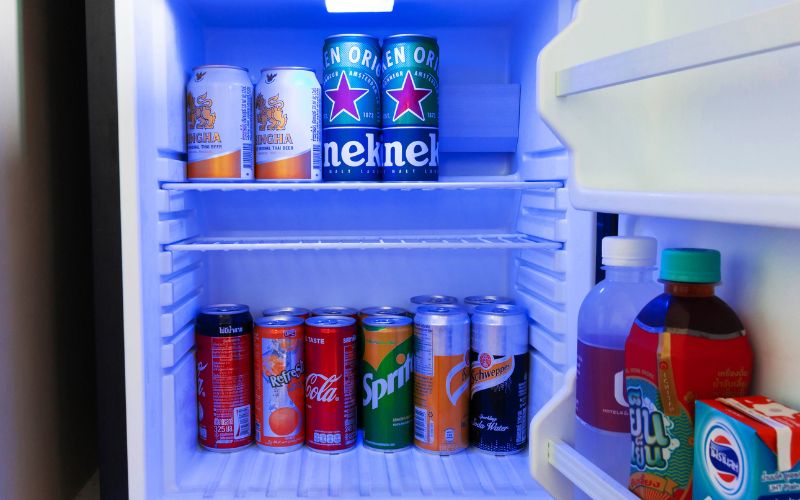Introduction
In the bustling world of commerce, the importance of commercial refrigeration cannot be overstated. From preserving perishable goods to enhancing food safety standards, commercial fridges play a crucial role in various industries. In this comprehensive guide, we’ll delve into the intricacies of commercial fridges, exploring their types, applications, maintenance, and much more.
What is a Commercial Fridge?
A commercial fridge is a refrigeration unit designed for use in commercial settings such as restaurants, grocery stores, and foodservice establishments. Unlike household refrigerators, commercial fridges are larger in size, have higher storage capacities, and are built to withstand continuous usage in demanding environments.
Why Are Commercial Fridges Important?
Commercial fridges are indispensable for businesses dealing with perishable goods. They help maintain optimal storage conditions, ensuring freshness and preventing spoilage. Additionally, they contribute to food safety by preserving perishable items at the recommended temperatures, thereby reducing the risk of contamination and foodborne illnesses.
Types and Categories
Commercial fridges come in various types and configurations, each catering to specific storage needs and space constraints. Let’s explore some common types:
1. Reach-In Refrigerators
These are upright refrigeration units with front-facing doors, resembling household refrigerators. They are ideal for storing frequently accessed items and come in various sizes to accommodate different storage capacities.
2. Walk-In Coolers
Walk-in coolers are large refrigerated storage spaces that allow for easy access and ample storage capacity. They are commonly used in restaurants, supermarkets, and warehouses to store bulk quantities of perishable goods.
3. Display Refrigerators
Display refrigerators, also known as glass door refrigerators, are designed to showcase chilled products such as beverages, desserts, and ready-to-eat meals. They feature glass doors for visibility, making them perfect for retail environments where aesthetics and product presentation are important.
4. Undercounter Refrigerators
Undercounter refrigerators are compact units that fit beneath countertops or work surfaces, making them ideal for space-constrained environments like bars, cafes, and food trucks. Despite their smaller size, they offer sufficient storage for storing ingredients or beverages within arm’s reach.
5. Specialty Refrigeration Units
These include specialized refrigeration equipment tailored to specific requirements, such as blast chillers for rapid cooling, wine coolers for preserving wine at optimal temperatures, and ice cream freezers for storing frozen treats.
Symptoms and Signs
Identifying issues with your commercial fridge is crucial for ensuring uninterrupted operation and preventing potential food spoilage. Here are some common symptoms that may indicate a malfunctioning fridge:
1. Temperature Fluctuations
Fluctuating temperatures inside the fridge can lead to inconsistent cooling and compromised food quality. It’s essential to monitor temperature settings regularly and invest in a reliable thermometer to ensure optimal storage conditions.
2. Excessive Frost Build-Up
Excessive frost accumulation on the evaporator coils or inside the freezer compartment can hinder airflow and reduce the fridge’s efficiency. Regular defrosting and cleaning of the unit can help prevent frost build-up and maintain optimal performance.
3. Unusual Noises
Loud or unusual noises such as buzzing, rattling, or humming may indicate mechanical issues or malfunctioning components within the fridge. Prompt inspection and maintenance by a qualified technician are necessary to diagnose and address the underlying cause.
4. Water Leakage
Water leakage around the fridge or inside the storage compartments can be a sign of blocked drainage channels, damaged door seals, or faulty internal components. Addressing leaks promptly is essential to prevent water damage and maintain hygiene standards.
5. Spoiled Food
If you notice signs of food spoilage such as foul odors, mold growth, or changes in texture and appearance, it’s crucial to investigate the cause promptly. Improper storage conditions or a malfunctioning fridge can accelerate food spoilage and pose health risks to consumers.
Causes and Risk Factors
Understanding the underlying causes of commercial fridge issues can help prevent breakdowns and ensure optimal performance. Here are some common causes and risk factors to consider:
1. Poor Maintenance
Inadequate maintenance practices such as infrequent cleaning, neglecting routine inspections, and ignoring minor issues can lead to significant problems over time. Regular maintenance checks, cleaning of condenser coils, and lubrication of moving parts are essential for preserving the longevity of the fridge.
2. Overloading
Overloading the fridge with excessive inventory can obstruct airflow and strain the compressor, leading to poor cooling performance and increased energy consumption. Adhering to recommended storage capacities and organizing items properly can prevent overloading and ensure efficient operation.
3. Temperature Mismanagement
Improper temperature settings or frequent temperature fluctuations can compromise food safety and quality. It’s essential to monitor temperature levels regularly, adjust settings as needed, and invest in temperature monitoring devices to maintain consistency.
4. Door Seal Damage
Damaged or worn-out door seals can allow warm air to enter the fridge, causing temperature fluctuations and energy wastage. Inspecting and replacing faulty door seals promptly can help maintain optimal cooling efficiency and prevent food spoilage.
5. Electrical Issues
Electrical problems such as faulty wiring, defective components, or power surges can disrupt the fridge’s operation and pose safety hazards. Regular electrical inspections, repairs by qualified technicians, and adherence to safety protocols are essential for preventing electrical failures.
Diagnosis and Tests
When troubleshooting commercial fridge issues, proper diagnosis is essential for identifying the root cause and implementing effective solutions. Here are some common diagnostic tools and tests used by technicians:
1. Temperature Monitoring
Using digital thermometers or data loggers to monitor temperature levels inside the fridge and freezer compartments. This helps identify temperature fluctuations and ensure compliance with food safety regulations.
2. Visual Inspection
Conducting a thorough visual inspection of the fridge’s interior and exterior components to check for signs of damage, corrosion, or wear. Focus areas include door seals, condenser coils, evaporator fans, and electrical connections.
3. Pressure Testing
Performing pressure tests on the refrigeration system to check for leaks, blockages, or pressure abnormalities. This involves connecting pressure gauges to the system’s service ports and comparing readings against recommended values.
4. Electrical Testing
Using multimeters or voltage testers to check electrical connections, circuitry, and components for continuity, voltage levels, and proper functioning. This helps identify electrical issues such as short circuits, faulty relays, or damaged wiring.
5. Performance Evaluation
Conducting performance tests such as compressor cycling tests, defrost cycle checks, and airflow assessments to evaluate the fridge’s overall performance and efficiency. This provides insights into system operation and identifies areas for improvement.
Treatment Options
Addressing commercial fridge issues promptly is essential for minimizing downtime, preventing food loss, and ensuring business continuity. Here are some common treatment options and repair strategies:
1. Cleaning and Maintenance
Regular cleaning of the fridge’s interior and exterior surfaces, including condenser coils, evaporator fans, and drainage channels, to remove dirt, debris, and microbial growth. This helps improve airflow, prevent blockages, and maintain hygiene standardsCertainly! Continuing from where we left off:
1. Cleaning and Maintenance (Continued)
Regular cleaning of the fridge’s interior and exterior surfaces, including condenser coils, evaporator fans, and drainage channels, to remove dirt, debris, and microbial growth. This helps improve airflow, prevent blockages, and maintain hygiene standards.
2. Door Seal Replacement
Replacing damaged or worn-out door seals to ensure a tight seal and prevent warm air infiltration. Proper sealing is essential for maintaining consistent temperatures and energy efficiency.
3. Refrigerant Recharge
Recharging or replenishing refrigerant levels in the system to restore cooling capacity and efficiency. Low refrigerant levels can lead to inadequate cooling and compressor strain, resulting in temperature fluctuations and increased energy consumption.
4. Component Repair or Replacement
Repairing or replacing faulty components such as compressors, evaporator fans, condenser coils, thermostats, and electrical relays. Timely replacement of worn-out or malfunctioning parts is essential for restoring optimal functionality and preventing further damage.
5. System Troubleshooting
Performing comprehensive troubleshooting of the refrigeration system to identify and address complex issues such as refrigerant leaks, compressor failures, or electrical malfunctions. This may require professional expertise and specialized diagnostic equipment.
Preventive Measures
Preventive maintenance plays a crucial role in prolonging the lifespan of commercial fridges and minimizing the risk of unexpected breakdowns. Here are some preventive measures to consider:
1. Regular Inspection
Schedule regular inspections by qualified technicians to check for signs of wear, damage, or malfunctioning components. This allows for early detection of potential issues and timely repairs before they escalate.
2. Temperature Monitoring
Monitor temperature levels using digital thermometers or automated monitoring systems to ensure compliance with food safety standards. Establish temperature logs and corrective action procedures in case of deviations from recommended ranges.
3. Cleaning Schedule
Implement a regular cleaning schedule for the fridge’s interior and exterior surfaces, including shelves, drawers, gaskets, and condenser coils. Use appropriate cleaning agents and techniques to remove dirt, grease, and food residues.
4. Door Maintenance
Inspect and maintain door seals regularly to ensure proper sealing and prevent air leaks. Clean door gaskets with mild detergent and warm water to remove debris and maintain flexibility.
5. Energy Efficiency Measures
Optimize energy efficiency by minimizing door openings, avoiding overloading, and maintaining proper airflow around the fridge. Consider investing in energy-efficient models or retrofitting existing units with energy-saving features.
Personal Stories or Case Studies
Real-life experiences can offer valuable insights into the importance of commercial fridges and the impact of effective refrigeration practices. Here are some personal stories highlighting the significance of proper refrigeration:
1. Restaurant Owner’s Experience
“As a restaurant owner, maintaining reliable refrigeration is crucial for preserving the quality and safety of our ingredients. We experienced a sudden fridge malfunction during a busy weekend, resulting in significant food spoilage and customer dissatisfaction. Since then, we’ve implemented a proactive maintenance schedule and invested in backup refrigeration units to prevent similar incidents.”
2. Grocery Store Manager’s Testimonial
“At our grocery store, ensuring consistent cooling across various departments is essential for customer satisfaction and food quality. We once encountered a refrigeration breakdown during a heatwave, leading to a temporary closure and loss of perishable inventory. We’ve since upgraded our refrigeration systems and implemented regular maintenance checks to avoid disruptions and uphold food safety standards.”
Expert Insights
Industry experts provide valuable advice and recommendations for optimizing commercial refrigeration practices. Here are some insights from refrigeration professionals:
1. Expert Opinion on Maintenance
“Regular maintenance is the cornerstone of efficient commercial refrigeration. By conducting thorough inspections, cleaning, and servicing of refrigeration equipment, businesses can prevent costly breakdowns, extend equipment lifespan, and ensure compliance with food safety regulations.”
2. Importance of Temperature Control
“Maintaining precise temperature control is paramount in commercial refrigeration, especially for businesses handling perishable goods. Investing in advanced temperature monitoring systems and calibration tools can help businesses achieve optimal storage conditions and prevent foodborne illnesses.”
Conclusion
In conclusion, commercial fridges play a vital role in preserving the quality, safety, and freshness of perishable goods in various industries. By understanding the different types, symptoms, causes, and maintenance practices associated with commercial refrigeration, businesses can ensure uninterrupted operation, minimize food waste, and uphold food safety standards. Regular maintenance, temperature monitoring, and adherence to best practices are essential for maximizing the efficiency and longevity of commercial fridges.





